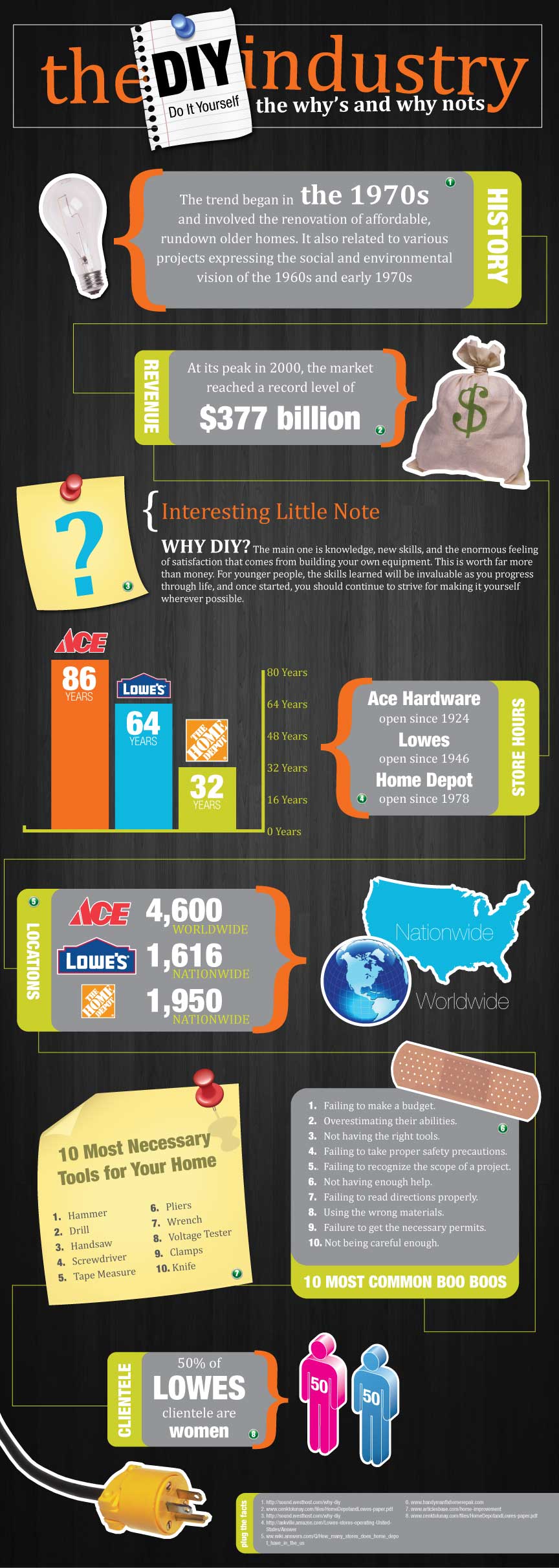
As crafters, the whole idea of DIY comes second nature. Since the 1970’s, the DIY industry has experienced many decades of evolving trends surrounding affordable renovation and constructing a space that is personalized and renovated by your own two hands. Many of these initial industry changes transpired over 40 years ago due to the concerns of social and environmental changes. In the 21st century, many millennials have transformed to similar ideals.
In the year 2000, the DIY industry hit its all time high of $377 billion annual revenue. The top store names in this marketplace is Ace Hardware, Lowes, and Home Depot. Having been around for over 8 decades, Ace Hardware offers more than 4,600 locations worldwide. Lowes and Home Depot on the other hand can be found nationally in over a thousand locations. More than half of Lowes clientele are determined to be women.
Most Common Mistakes for DIY Shoppers
Some of the most common mistakes for DIY shoppers looking to venture out on their own are listed below.
1. Failing to make a budget.
2. Overestimating their tasks and abilities.
3. Not having the proper tools available.
4. Failing to follow safety precautions.
5. Failing to recognize the scope of the project.
6. Not having additional help available.
7. Failing to read and follow directions.
8. Using the wrong materials.
9. Failing to get required permits.
10. Not proceeding with caution.
Many DIY consumers look to purchase their products through home centers, followed by lumberyards and hardware stores. All of these types of stores combined amount to an annual revenue of $308.3 billion in the United States in 2013.
The Impact of Sustainability
Many DIYers prefer the idea of purchasing sustainable products. On a global scale, sustainable products saw an increase in demand from 45% in 2011 to 55% in 2014. Interesting enough some of the most wealthiest countries in the world were willing to pay less for sustainability than those that lived in less developed nations. In North America and Europe, only 42% and 40% of consumers were willing to pay more for products produced by socially responsible companies. The following statistics show what percentage more consumers are willing to pay worldwide.
Asia-Pacific – 64%
Latin America – 63%
Middle East/Africa – 63%
North America – 42%
Europe – 40%
Global Average – 55%
Top DIY Market Segments of 2013
In 2013, the average DIY consumer had a project in mind of what it was they wanted to accomplish. Many plan to decorate or redecorate in the next 2 years with more than 40% desiring to remodel their home or build an addition. To understand the average DIY consumer, the top home improvement tasks on their list are provided below.
1. Bathroom Renovation – 28%
2. Kitchen Remodel – 23%
3. Flooring, Paneling, or Ceiling Replacement – 18%
4. Patio or Landscape Renovation or Addition – 18%
5. Windows and Doors Remodel – 15%
6. Deck or Porch Addition or Replacement – 14%
7. Closet Addition or Alteration – 12%
8. Bedroom Addition or Renovation – 11%
9. Living or Family Room Remodel – 10%
The hardware industry alone is expected to rebound over the next 5 years, growing at an annualized rate of 1.2% to $23.3 billion.






Just wondering what are these statistics based off of? was there a study done?
All of the references of the statistics are located in bottom part of the infographic. Hope this helps.